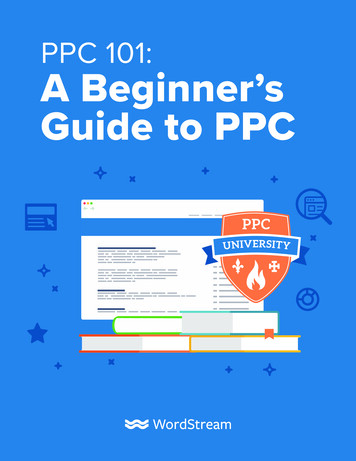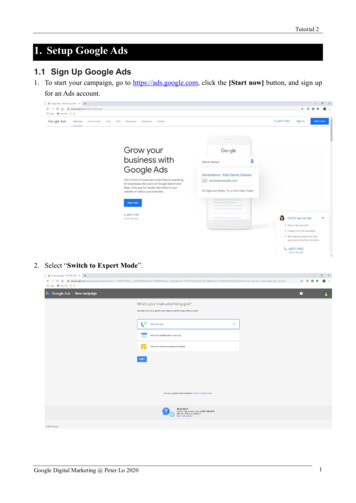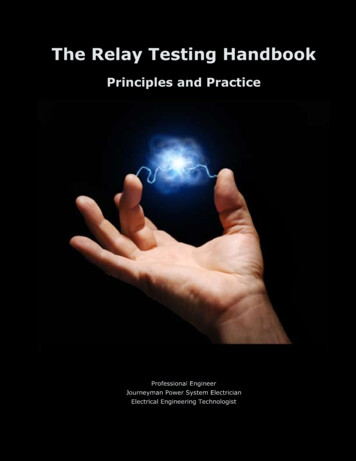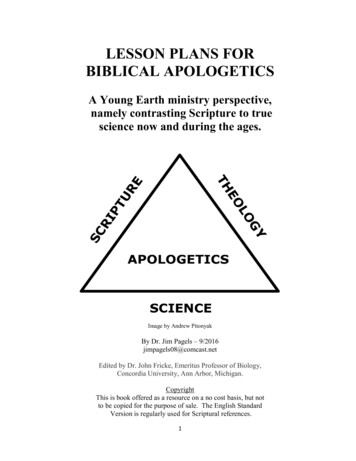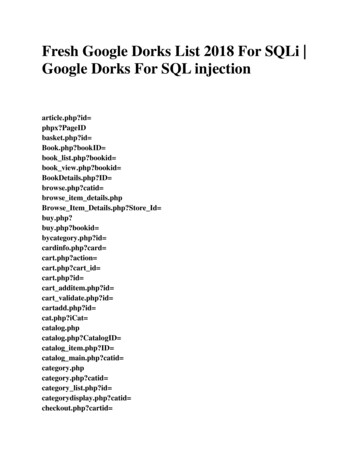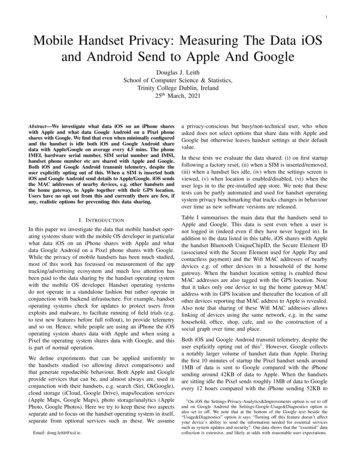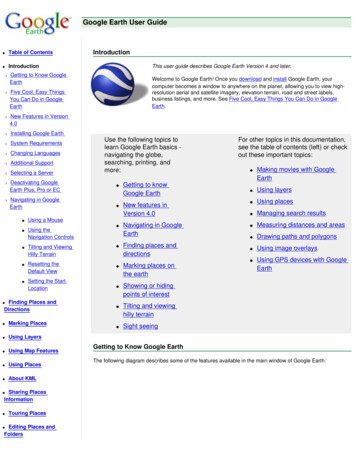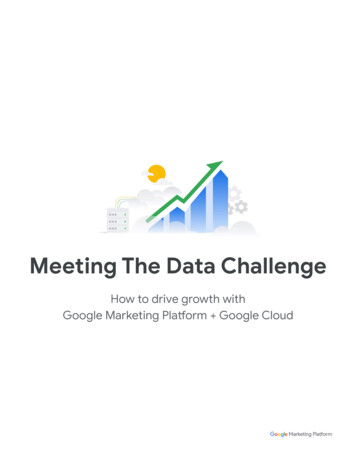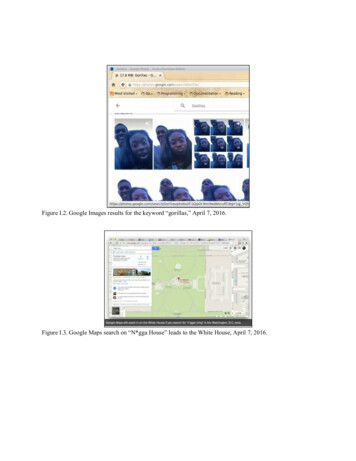
Transcription
this issue quickly.’”7Figure I.2. Google Images results for the keyword “gorillas,” April 7, 2016.Figure I.3. Google Maps search on “N*gga House” leads to the White House, April 7, 2016.17
Figure I.4. Tweet by Deray McKesson about Google Maps search and the White House, 2015.Figure I.5. Standard Google’s “related” searches associates “Michelle Obama” with the term “ape.”***These human and machine errors are not without consequence, and there are several cases thatdemonstrate how racism and sexism are part of the architecture and language of technology, anissue that needs attention and remediation. In many ways, these cases that I present are specificto the lives and experiences of Black women and girls, people largely understudied by scholars,who remain ever precarious, despite our living in the age of Oprah and Beyoncé in Shondaland.18
Figure 1.1. Memac Ogilvy & Mather Dubai advertising campaign for the United Nations.One limitation of looking at the implications of search is that it is constantly evolving andshifting over time. This chapter captures aspects of commercial search at a particular moment—from 2009 to 2015—but surely by the time readers engage with it, it will be a historical ratherthan contemporary study. Nevertheless, the goal of such an exploration of why we gettroublesome search results is to help us think about whether it truly makes sense to outsource allof our knowledge needs to commercial search engines, particularly at a time when the public isincreasingly reliant on search engines in lieu of libraries, librarians, teachers, researchers, andother knowledge keepers and resources.What is even more crucial is an exploration of how people living as minority groups under theinfluence of a majority culture, such as people of color and sexual minorities in the UnitedStates, are often subject to the whims of the majority and other commercial influences such asadvertising when trying to affect the kinds of results that search engines offer about them andtheir identities. If the majority rules in search engine results, then how might those who are in theminority ever be able to influence or control the way they are represented in a search engine?The same might be true of how men’s desires and usage of search is able to influence the valuesthat surround women’s identities in search engines, as the Ogilvy campaign might suggest. Forthese reasons, a deeper exploration into the historical and social conditions that give rise toproblematic search results is in order, since rarely are they questioned and most Internet usershave no idea how these ideas come to dominate search results on the first page of results in thefirst place.23
entered with digital information tools? And who among us did not have to bargain in this way?As a Black woman growing up in the late twentieth century, I also knew that the presentation ofBlack women and girls that I discovered in my search results was not a new development of thedigital age. I could see the connection between search results and tropes of African Americansthat are as old and endemic to the United States as the history of the country itself. Mybackground as a student and scholar of Black studies and Black history, combined with mydoctoral studies in the political economy of digital information, aligned with my righteousindignation for Black girls everywhere. I searched on.Figure 1.2. First page of search results on keywords “black girls,” September 18, 2011.25
Figure 1.3. First page of image search results on keywords “black girls,” April 3, 2014.Figure 1.4. Google autosuggest results when searching the phrase “why are black people so,” January 25,2013.26
Figure 1.5. Google autosuggest results when searching the phrase “why are black women so,” January 25,2013.Figure 1.6. Google autosuggest results when searching the phrase “why are white women so,” January 25,2013.27
Figure 1.7. Google Images results when searching the concept “beautiful” (did not include the word “women”),December 4, 2014.Figure 1.8. Google Images results when searching the concept “ugly” (did not include the word “women”),January 5, 2013.28
Figure 1.9. Google Images results when searching the phrase “professor style” while logged in as myself,September 15, 2015.What each of these searches represents are Google’s algorithmic conceptualizations of avariety of people and ideas. Whether looking for autosuggestions or answers to various questionsor looking for notions about what is beautiful or what a professor may look like (which does notaccount for people who look like me who are part of the professoriate—so much for“personalization”), Google’s dominant narratives reflect the kinds of hegemonic frameworks andnotions that are often resisted by women and people of color. Interrogating what advertisingcompanies serve up as credible information must happen, rather than have a public instantlygratified with stereotypes in three-hundredths of a second or less.In reality, information monopolies such as Google have the ability to prioritize web searchresults on the basis of a variety of topics, such as promoting their own business interests over29
Figure 1.10. Automated headline generated by software and tweeted about Keith Lamont Scott, killed bypolice in North Carolina on September 20, 2016, as reported by the Los Angeles Times.34
complexities of human intervention involved in vetting of information, nor do they pay attentionto the relative weight or importance of certain types of information.36 For example, in theprocess of citing work in a publication, all citations are given equal weight in the bibliography,although their relative importance to the development of thought may not be equal at all.Additionally, no relative weight is given to whether a reference is validated, rejected, employed,or engaged—complicating the ability to know what a citation actually means in a document.Authors who have become so mainstream as not to be cited, such as not attributing moderndiscussions of class or power dynamics to Karl Marx or the notion of “the individual” to thescholar of the Italian Renaissance Jacob Burckhardt, mean that these intellectual contributionsmay undergird the framework of an argument but move through works without being cited anylonger. Concepts that may be widely understood and accepted ways of knowing are rarely citedin mainstream scholarship, an important dynamic that Linda Smith, former president of theAssociation for Information Science and Technology (ASIS&T) and associate dean of theInformation School at the University of Illinois at Urbana-Champaign, argues is part of theflawed system of citation analysis that deserves greater attention if bibliometrics are to serve as alegitimating force for valuing knowledge production.Figure 1.11. Example of Google’s prioritization of its own properties in web search. Source: Inside Google(2010).Brin and Page saw the value in using works that others cite as a model for thinking aboutdetermining what is legitimate on the web, or at least to indicate what is popular based on many41
Figure 1.12. Explanation of results by Google. Source: www.google.com/ explanation.html (originally availablein 2005).The public’s as well as the Jewish community’s interest in accurate information about Jewishculture and the Holocaust should be enough motivation to provoke a national discussion aboutconsumer harm, to which my research shows we can add other cultural and gender-basedidentities that are misrepresented in search engines. However, Google’s assertion that its searchresults, though problematic, were computer generated (and thus not the company’s fault) wasapparently a good-enough answer for the Anti-Defamation League (ADL), which declared, “Weare extremely pleased that Google has heard our concerns and those of its users about theoffensive nature of some search results and the unusually high ranking of peddlers of bigotry andanti-Semitism.”43 The ADL does acknowledge on its website its gratitude to Sergey Brin,cofounder of Google and son of Russian Jewish immigrants, for his personal letter to the44
organization and his mea culpa for the “Jew” search-term debacle. The ADL generously stated inits press release about the incident that Google, as a resource to the public, should be forgivenbecause “until the technical modifications are implemented, Google has placed text on its sitethat gives users a clear explanation of how search results are obtained. Google searches areautomatically determined using computer algorithms that take into account thousands of factorsto calculate a page’s relevance.”44If there is a technical fix, then what are the constraints that Google is facing such that eightyears later, the issue has yet to be resolved? A search for the word “Jew” in 2012 produces abeige box at the bottom of the results page from Google linking to its lengthy disclaimer aboutthe results—which remain a mix of both anti-Semitic and informative sites (see figure 1.13).That Google places the responsibility for bad results back on the shoulders of informationsearchers is a problem, since most of the results that the public gets on broad or open-endedracial and gendered searches are out of their control and entirely within the control of GoogleSearch.Figure 1.13. Google’s bottom-of-the-page beige box regarding offensive results, which previously took usersto “An Explanation of Our Search Results.” Source: www.google.com/ explanation (no longer available).It is important to note that Google has conceded the fact that anti-Semitism as the primaryinformation result about Jewish people is a problem, despite its disclaimer that tries to put theonus for bad results on the searcher. In Germany and France, for example, it is illegal to sell Nazimemorabilia, and Google has had to put in place filters that ensure online retailers of such are notvisible in search results. In 2002, Benjamin Edelman and Jonathan Zittrain at HarvardUniversity’s Berkman Center for Internet and Society concluded that Google was filtering itssearch results in accordance with local law and precluding neo-Nazi organizations and content45
Figure 1.14. Example of a Google bomb on George W. Bush and the search terms “miserable failure,” 2005.All of these practices of search engine optimization and Google bombing can take placeindependently of and in concert with the process of crawling and indexing the web. In fact, beingfound gives meaning to a website and creates the conditions in which a ranking can happen.Search engine optimization is a major factor in findability on the web. What is important to noteis that search engine optimization is a multibillion-dollar industry that impacts the value ofspecific keywords; that is, marketers are invested in using particular keywords, and keywordcombinations, to optimize their rankings.Despite the widespread beliefs in the Internet as a democratic space where people have thepower to dynamically participate as equals, the Internet is in fact organized to the benefit ofpowerful elites,51 including corporations that can afford to purchase and redirect searches to theirown sites. What is most popular on the Internet is not wholly a matter of what users click on andhow websites are hyperlinked—there are a variety of processes at play. Max Holloway of SearchEngine Watch notes, “Similarly, with Google, when you click on a result—or, for that matter,don’t click on a result—that behavior impacts future results. One consequence of this complexityis difficulty in explaining system behavior. We primarily rely on performance metrics to quantifythe success or failure of retrieval results, or to tell us which variations of a system work betterthan others. Such metrics allow the system to be continuously improved upon.”52 The goal ofcombining search terms, then, in the context of the landscape of the search engine optimizationlogic, is only the beginning.Much research has now been done to dispel the notion that users of the Internet have the48
The Cultural Power of AlgorithmsThe public is minimally aware of these shifts in the cultural power and import of algorithms. In a2015 study by the Pew Research Center, “American’s Privacy Strategies Post-Snowden,” only34% of respondents who were aware of the surveillance that happens automatically onlinethrough media platforms, such as search behavior, email use, and social media, reported that theywere shifting their online behavior because of concerns of government surveillance and thepotential implications or harm that could come to them.66 Little of the American public knowsthat online behavior has more importance than ever. Indeed, Internet-based activities aredramatically affecting our notions of how democracy and freedom work, particularly in the realmof the free flow of information and communication. Our ability to engage with the informationlandscape subtly and pervasively impacts our understanding of the world and each other.Figure 1.15. Forbes’s online reporting (and critique) of the Epstein and Robertson study.An example of how information flow and bias in the realm of politics have recently come tothe fore can be found in an important new study about how information bias can radically alterelection outcomes. The former editor of Psychology Today and professor Robert Epstein andRonald Robertson, the associate director of the American Institute for Behavioral Research andTechnology, found in their 2013 study that democracy was at risk because manipulating searchrankings could shift voters’ preferences, substantially and without their awareness. In their study,they note that the tenor of stories about a candidate in search engine results, whether favorable orunfavorable, dramatically affected the way that people voted. Seventy-five percent ofparticipants were not aware that the search results had been manipulated. The researchersconcluded, “The outcomes of real elections—especially tight races—can conceivably bedetermined by the strategic manipulation of search engine rankings and . . . that the manipulationcan be accomplished without people being aware of it. We speculate that unregulated search51
Figure 2.1. First page of search results on keywords “black girls,” September 18, 2011.63
Figure 2.2. First page (partial) of results on “black girls” in a Google search with the first result’s detail andadvertising.Figure 2.3. First results on the first page of a keyword search for “black girls” in a Google search.In the case of the first page of results on “black girls,” I clicked on the link for both the topsearch result (unpaid) and the first paid result, which is reflected in the right-hand sidebar, whereadvertisers that are willing and able to spend money through Google AdWords4 have theircontent appear in relationship to these search queries.5 All advertising in relationship to Blackgirls for many years has been hypersexualized and pornographic, even if it purports to be justabout dating or social in nature. Additionally, some of the results such as the UK rock bandBlack Girls lack any relationship to Black women and girls. This is an interesting co-optation ofidentity, and because of the band’s fan following as well as possible search engine optimizationstrategies, the band is able to find strong placement for its fan site on the front page of theGoogle search.64
Figure 2.4. Snapchat faced intense media scrutiny in 2016 for its “Bob Marley” and “yellowface” filters thatwere decried as racist stereotyping.Published text on the web can have a plethora of meanings, so in my analysis of all of theseresults, I have focused on the implicit and explicit messages about Black women and girls in boththe texts of results or hits and the paid ads that accompany them. By comparing these to broadersocial narratives about Black women and girls in dominant U.S. popular culture, we can see theways in which search engine technology replicates and instantiates these notions. This is nosurprise when Black women are not employed in any significant numbers at Google. Not onlyare African Americans underemployed at Google, Facebook, Snapchat, and other populartechnology companies as computer programmers, but jobs that could employ the expertise ofpeople who understand the ramifications of racist and sexist stereotyping and misrepresentationand that require undergraduate and advanced degrees in ethnic, Black / African American,women and gender, American Indian, or Asian American studies are nonexistent.One cannot know about the history of media stereotyping or the nuances of structuraloppression in any formal, scholarly way through the traditional engineering curriculum of thelarge research universities from which technology companies hire across the United States.Ethics courses are rare, and the possibility of formally learning about the history of Black womenin relation to a series of stereotypes such as the Jezebel, Sapphire, and Mammy does not exist inmainstream engineering programs. I can say that when I teach engineering students at UCLAabout the histories of racial stereotyping in the U.S. and how these are encoded in computerprogramming projects, my students leave the class stunned that no one has ever spoken of thesethings in their courses. Many are grateful to at least have had ten weeks of discussion about thepolitics of technology design, which is not nearly enough to prepare them for a lifelong career in65
67
Figure 2.5. Google search on “Asian girls,” 2011.68
Figure 2.6. Google search on “Asian Indian” girls in 2011.69
Figure 2.7. Google search on “Hispanic girls” in 2011.70
Figure 2.8. Google search on “Latina girls” in 2011.71
Figure 2.9. Google search on “American Indian girls” in 2011.72
Figure 2.10. Google search on “white girls” in 2011.73
Figure 2.11. Google search on “African American girls” in 2011.The leading thinking about race online has been organized along either theories of racialformation6 or theories of hierarchical and structural White supremacy.7 Scholars who study racepoint to the aggressive economic and social policies in the U.S. that have been organized aroundideological conceptions of race as “an effort to reorganize and redistribute resources alongparticular racial lines.”8 Vilna Bashi Treitler, a professor of sociology and chair of theDepartment of Black Studies at the University of California, Santa Barbara, has writtenextensively about the processes of racialization that occur among ethnic groups in the UnitedStates, all of which are structured through a racial hierarchy that maintains Whiteness at the topof the social, political, and economic order. For Treitler, theories of racial formation are lesssalient—it does not matter whether one believes in race or not, because it is a governing74
I responded again, “If Google isn’t responsible for its algorithm, then who is?” One of Ali’sTwitter followers later posted a tweak to the algorithm made by Google on a search for “threewhite teens” that now included a newly introduced “criminal” image of a White teen and more“wholesome” images of Black teens.Figure 2.12. Kabir Ali’s tweet about his searching for “three black teenagers” shows mug shots, 2016.76
Figure 2.13. Kabir Ali’s tweet about his searching for “three white teenagers” shows wholesome teens in stockphotography, 2016.What we know about Google’s responses to racial stereotyping in its products is that ittypically denies responsibility or intent to harm, but then it is able to “tweak” or “fix” theseaberrations or “glitches” in its systems. What we need to ask is why and how we get thesestereotypes in the first place and what the attendant consequences of racial and genderstereotyping do in terms of public harm for people who are the targets of such misrepresentation.Images of White Americans are persistently held up in Google’s images and in its results toreinforce the superiority and mainstream acceptability of Whiteness as the default “good” towhich all others are made invisible. There are many examples of this, where users of GoogleSearch have reported online their shock or dismay at the kinds of representations thatconsistently occur. Some examples are shown in figures 2.14 and 2.15. Meanwhile, when userssearch beyond racial identities and occupations to engage concepts such as “professionalhairstyles,” they have been met with the kinds of images seen in figure 2.16. The “unprofessionalhairstyles for work” image search, like the one for “three black teenagers,” went viral in 2016,with multiple media outlets covering the story, again raising the question, can algorithms beracist?77
Figure 2.14. Google Images search on “doctor” featuring men, mostly White, as the dominant representation,April 7, 2016.Figure 2.15. Google Images search on “nurse” featuring women, mostly White, as the dominant representation,April 7, 2016.78
Figure 2.16. Tweet about Google searches on “unprofessional hairstyles for work,” which all feature Blackwomen, while “professional hairstyles for work” feature White women, April 7, 2016.Understanding technological racialization as a particular form of algorithmic oppressionallows us to use it as an important framework in which to critique the discourse of the Internet asa democratic landscape and to deploy alternative thinking about the practices instantiated withincommercial web search. The sociologist and media studies scholar Jessie Daniels makes asimilar argument in offering a key critique of those scholars who use racial formation theory asan organizing principle for thinking about race on the web, arguing that, instead, it would bemore potent and historically accurate to think about White supremacy as the dominant lens andstructure through which sense-making of race online can occur. In short, Daniels argues thatusing racial formation theory to explain phenomena related to race online has been detrimental toour ability to parse how power online maps to oppression rooted in the history of White79
supremacist debasement of Black women. Dressed in blackface, he adorned the top of a cake hemade that was a provocative art experiment gone wrong, at the expense of Black women. Theseimages are just one of many that make up the landscape of racist misogyny. After an outpouringof international disgust, Liljeroth denied any possibility that the project, and her participation,could be racist in tone or presentation.57Figure 2.17. Google search for Sara Baartman, in preparation for a lecture on Black women in film, January22, 2013.90
Figure 2.18. Lena Adelsohn Liljeroth, Swedish minister of culture, feeds cake to the artist Makode Aj Linde inblackface, at the Moderna Museet in Stockholm, 2012.Figure 2.19. Makode Aj Linde’s performance art piece at Moderna Museet. Source: www.forharriet.com,2012.During slavery, stereotypes were used to justify the sexual victimization of Black women bytheir property owners, given that under the law, Black women were property and therefore couldnot be considered victims of rape. Manufacture of the Jezebel stereotype served an important role91
Figure 2.20. One dominant narrative stereotype of Black women, the Jezebel Whore, depicted here over morethan one hundred years of cultural artifacts. Source: Jim Crow Museum of Racist Memorabilia at Ferris StateUniversity, www.ferris.edu.93
Figure 2.21. Google video search results on “black girls,” June 22, 2016.Although Google changed its algorithm in late summer 2012 and suppressed pornography asthe primary representation of Black girls in its search results, by 2016, it had also modified thealgorithm to include more diverse and less sexualized images of Black girls in its image searchresults, although most of the images are of women and not of children or teenagers (girls).However, the images of Black girls remain troubling in Google’s video search results, withnarratives that mostly reflect user-generated content (UGC) that engages in comedic portrayalsof a range stereotypes about Black / African American girls. Notably, the White nationalist ColinFlaherty’s work, which the Southern Poverty Law Center has described as propaganda to inciteracial violence and White anxiety, is the producer of the third-ranked video to represent Blackgirls.Porn on the Internet is an expansion of neoliberal capitalist interests. The web itself hasopened up new centers of profit and pushed the boundaries of consumption. Never before havethere been so many points for the transmission and consumption of these representations of97
organizations through a variety of “hacktivist” online takedowns, as seen in figure 3.3.4Figure 3.1. Google search on the phrase “black on white crimes” in Los Angeles, CA, August 3, 2015.105
Figure 3.2. Google search on the phrase “black on white crimes” in Madison, WI, August 5, 2015.Figure 3.3. On May 14, 2014, NewNation.org published this notice on its website to alert its members to thehack.106
teachers, books, history, and experience. Search results, in the context of commercial advertisingcompanies, lay the groundwork, as I have discussed throughout this book, for implicit bias: biasthat is buttressed by advertising profits. Search engine results also function as a type of personalrecord and as records of communities, albeit unstable ones. In the context of commercial search,they signal what advertisers think we want, influenced by the kinds of information algorithmsprogrammed to lead to popular and profitable web spaces. They galvanize attention, no matterthe potential real-life cost, and they feign impartiality and objectivity in the process of displayingresults, as detailed in chapter 1. In the case of the CCC, 579 websites link into the CCC’s URLwww.conservative-headlines.com from all over the world, including from sites as prominent asyahoo.com, msn.com, reddit.com, nytimes.com and huffingtonpost.com.Figure 3.4. Cloaked “news” website of the White supremacist organization CCC, August 5, 2015.A straight line cannot be drawn between search results and murder. But we cannot ignore theways that a murderer such as Dylann Roof, allegedly in his own words, reported that his racialawareness was cultivated online by searching on a concept or phrase that led him to very narrow,hostile, and racist views. He was not led to counterpositions, to antiracist websites that coulddescribe the history of the CCC and its articulated aims in its Statement of Principles that reflecta long history of anti-Black, anti-immigrant, antigay, and anti-Muslim fervor in the UnitedStates. What we need is a way to reframe, reimagine, relearn, and remember the struggle forracial and social justice and to see how information online in ranking systems can also impactbehavior and thinking offline. There is no federal, state, or local regulation of the psychologicalimpact of the Internet, yet big-data analytics and algorithms derived from it hold so much powerin overdetermining decisions. Algorithms that rank and prioritize for profits compromise our108
on the open web and what belongs to communities with shared values, to be shared within acommunity:In talking to some queer pornographers, I’ve learned that some of their former models arenow elementary school teachers, clergy, professors, child care workers, lawyers, mechanics,health care professionals, bus drivers and librarians. We live and work in a society that ishomophobic and not sex positive. Librarians have an ethical obligation to steward thiscontent with care for both the object and with care for the people involved in producing it.32Figure 4.1. Call to librarians not to digitize sensitive information that was meant to be private, by TaraRobertson.On Our Backs has an important history. It is regarded as the first lesbian erotica magazine tobe run by women, and its title was a cheeky play on the name of a second-wave, and oftenantipornography, feminist newspaper named Off Our Backs. On Our Backs stood in the sexpositive margin for lesbians who were often pushed out of the mainstream feminist and gayliberation movements of the 1970s–1990s. What Robertson raises are the ethical considerationsthat arise when participants in marginalized communities are unable to participate in the decisionmaking of having content they create circulate to a far wider, and outsider, audience. These arethe kinds of issues facing information workers, from the digitization of indigenous knowledgefrom all corners of the earth that are not intended for mass public consumption, to individualrepresentations that move beyond the control of the subject. We cannot ignore the long-termconsequences of what it means to have everything subject to public scrutiny, out of context, outof control.Ultimately, what I am calling for is increased regulation that is undergirded by research thatshows the harmful effects of deep machine-learning algorithms, or artificial intelligence, onsociety. It is not just a matter of concern for Google, to be fair. These are complex issues thatspan a host of institutions and companies. From the heinous effects manifested from DylannRoof’s searching on false concepts about African Americans that may have influenced his effort119
left with a very small “core.” An image that shows the complexity of these overlappingcategories is that of a huge Venn diagram with many sets limited by Boolean ANDs. Thewhite AND male AND straight AND European AND Christian AND middle-class ANDable-bodied AND Anglo mainstream becomes a very small minority . . . , and each setimplies what it is not. The implication of this image is that not every person, not everydiscourse, not every concept, has equal weight. Some discourses simply wield more powerthan others.28Arguably, if education is based in evidence-based research, and knowledge is a means ofliberation in society, then the types of knowledge that widely circulate provide a crucial site
Search engine optimization is a major factor in findability on the web. What is important to note is that search engine optimization is a multibillion-dollar industry that impacts the value of specific keywords; that is, marketers are invested in using particular keywor

